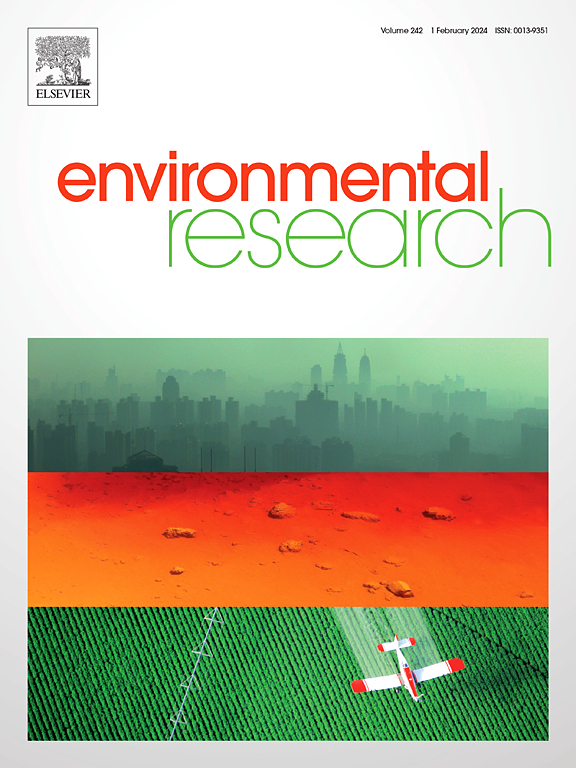水流梯度降低对底栖生物膜群落生态网络和群落组合的影响。
IF 7.7
2区 环境科学与生态学
Q1 ENVIRONMENTAL SCIENCES
引用次数: 0
摘要
人类活动的加剧导致全球大部分河流流量减少和断流,严重影响了河流生物和生物地球化学过程。底栖生物膜作为河流生态系统结构和功能的关键指标,在推动河流初级生产和物质循环方面发挥着至关重要的作用。本研究旨在调查河流流量减少时微生物群落的复杂性和稳定性特征。研究人员在人工河道中生长底栖生物薄膜,并对其进行了八次梯度减流(流速从 0.4 厘米/秒到 110 厘米/秒不等)。通过高通量测序研究了生物膜的生物多样性、生态网络以及细菌、真菌和藻类的群落组合。结果表明,不同水流条件下的群落组成和结构存在明显差异。八个水流梯度的微生物群落被分为三组:低水流、中水流和高水流。流量减少导致细菌和真菌群落的 Chao1 指数显著下降。低流量条件下,富集了细菌门氧光合细菌、变形杆菌和腔肠动物门,但显著降低了真菌门糜烂菌门。降低流量减少了真菌网络的节点数,增加了藻类网络的边缘数。跨域相互作用网络分析显示,随着流量的减少,节点和边的数量逐渐增加,而平均路径长度却在减少。中性模型预测随机过程是生物膜群落集结的主要驱动力,随着水流梯度的减小,该模型的解释也随之减少。空模型分析表明,扩散限制是细菌和藻类群落最常见的随机生态过程,流量减少会减少异质性选择,增加扩散限制过程。这项研究深入分析了水流减少对生物膜群落生态网络和群落组装的影响。本文章由计算机程序翻译,如有差异,请以英文原文为准。

Effects of reduced flow gradient on benthic biofilm communities’ ecological network and community assembly
The intensification of human activities has led to flow reduction and cut-off in most global rivers, seriously affecting riverine organisms and the biogeochemical processes. As key indicators of river ecosystems' structure and function, benthic biofilms play a critical role in driving primary production and material cycling in rivers. This research aimed to investigate the characteristics of microbial communities' complexity and stability during river flow reduction. Benthic biofilms were grown in artificial channels and subjected to eight gradients of flow reduction (represented by flow velocity from 0.4 to 110 cm/s). Biofilms' biodiversity, ecological networks and community assembly of bacteria, fungi and algae were investigated by high-throughput sequencing. Results showed significant differences in community composition and structure under different flow conditions. The eight flow gradients' microbial communities were divided into three groups: low, medium and high flows. The flow reduction led to significant decreases in bacterial and fungal communities' Chao1 index. Low flow conditions enriched the bacterial phyla Oxyphotobacteria, Alphaproteobacteria and Mollicutes, but significantly decreased the fungal phylum Chytridiomycota. Lowering flow reduced the fungal network's number of nodes and increased the algal network's number of edges. Cross-domain interactions network analysis showed a gradual increase in node and edge numbers with decreasing flow, while decreasing average path length. The neutral model predicted stochastic processes primarily drove biofilm community assembly, and that model's explanations decreased as the flow gradient decreased. The null model analysis revealed diffusion limitation as the most common stochastic ecological process for bacterial and algal communities, with reduced flow reducing heterogeneous selection and increasing diffusion-limited processes. This study provides an in-depth analysis of flow reduction's effects on biofilm communities' ecological networks and community assembly.
求助全文
通过发布文献求助,成功后即可免费获取论文全文。
去求助
来源期刊

Environmental Research
环境科学-公共卫生、环境卫生与职业卫生
CiteScore
12.60
自引率
8.40%
发文量
2480
审稿时长
4.7 months
期刊介绍:
The Environmental Research journal presents a broad range of interdisciplinary research, focused on addressing worldwide environmental concerns and featuring innovative findings. Our publication strives to explore relevant anthropogenic issues across various environmental sectors, showcasing practical applications in real-life settings.
 求助内容:
求助内容: 应助结果提醒方式:
应助结果提醒方式:


